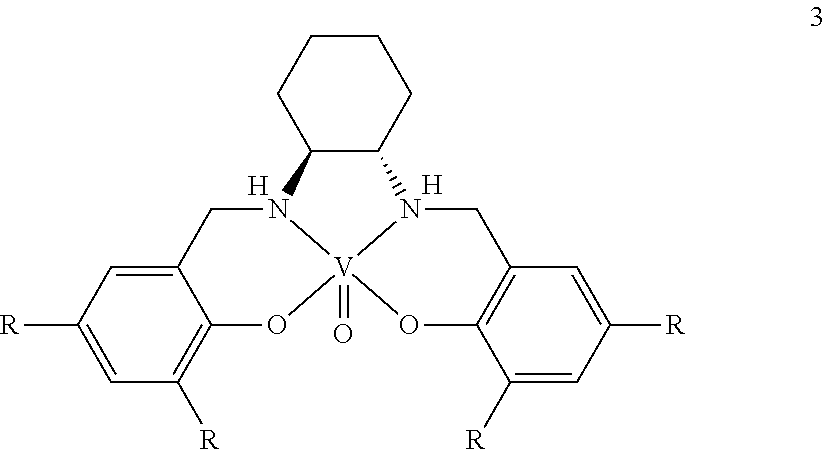Process for the preparation of enantiomerically enriched proton pump inhibitors
a proton pump inhibitor and enantiomer technology, applied in the field of process for the preparation of enantiomerically enriched proton pump inhibitors, can solve the problems of large amount of waste generated, less suitable for esomeprazole preparation, and poor method performance, and achieves excellent results, low toxicity, and limited amount of metal catalysts
- Summary
- Abstract
- Description
- Claims
- Application Information
AI Technical Summary
Benefits of technology
Problems solved by technology
Method used
Image
Examples
examples 1-18
Preparation of enantiomerically enriched 5-methoxy-2-[[(4-methoxy-3,5-dimethyl-2-pyridinyl)methyl]sulfinyl]-1H-benzimidazole (1a) using preformed (salen)metal complexes
[0126]General procedure: 5-Methoxy-2-[[(4-methoxy-3,5-dimethyl-2-pyridyl)methyl]thio]-1H-benzimidazole (4a) and the (salen)manganese complex 2a-e are dissolved in acetonitrile. The reaction temperature is adjusted, then 30% aqueous H2O2 is added dropwise and the mixture is stirred for several hours. Then the reaction mixture is transferred portion-wise into a cold (0° C.) 10% aqueous solution of Na2SO3 and stirred for additional 15 min. The obtained mixture is extracted with dichloromethane. The organic phase is dried over Na2SO4 and concentrated yielding an oily residue which is analyzed by chiral and achiral HPLC analytical method.
[0127]Typically, runs were carried out on 0.5-6 mmol scale of the starting material 4a in acetonitrile (1 mmol 4a in 10 mL MeCN). The amounts of added reagents, temperature and reaction ti...
example 19
[0128]5-Methoxy-2-[[(4-methoxy-3,5-dimethyl-2-pyridyl)methyl]thio]-1H-benzimidazole (4a) (19.74 g, 60 mmol) and (R,R)-(−)-N,N′-bis(3,5-di-tert-butylsalicylidene)-1,2-cyclohexanediamino-manganese(III) chloride 2a (0.953 g, 2.5 mol %) are dissolved in acetonitrile (900 ml). The reaction mixture is cooled to −10° C. and 30% aqueous H2O2 (275 ml, 45 mol equiv.) is added dropwise over 3 hours. The reaction mixture is stirred for additional 8 hours. HPLC analysis shows formation of 40% of sulfoxide with 56% enantiomeric excess (S-enriched). Then 10% aqueous Na2SO3 (2 I) is slowly added to the reaction mixture and it is extracted with EtOAc (2×2 l). The combined organic phases dried over Na2SO4. The concentrated oily residue is further dissolved in 0.1 M NaOH (2 l) and extracted with toluene / acetonitrile (9:1, 2×750 ml). To the water phase 1 M aqueous HCl is added until pH 9.4 and it is extracted with EtOAc (1 l). The EtOAc phase is dried over Na2SO4 and the solvent evaporated yielding oil...
example 20
[0129]5-Methoxy-2-[[(4-methoxy-3,5-dimethyl-2-pyridyl)methyl]thio]-1H-benzimidazole (4a) (0.987 g, 3 mmol) and (R,R)-(−)-N,N′-bis(3,5-di-tert-butylsalicylidene)-1,2-cyclohexanediamino-manganese(III) chloride (2a) (0.143 g, 7.5 mol %) are dissolved in acetonitrile (45 ml). The reaction mixture is cooled to −10° C. and 30% aqueous H2O2 (13.8 ml, 45 mol eqiuv) is added dropwise over 6 hours. The reaction mixture is stirred for additional 2 hours. Then the cold reaction mixture is transferred portionwise into a cold (0° C.) 15% aqueous Na2SO3 and stirred for additional 15 min. The pH of the mixture is adjusted to 9 and the precipitated salts are filtered off. The filtrate is extracted with dichloromethane (2×75 ml) and the combined organic phases are dried over Na2SO4. The solvent is evaporated yielding 1.15 g of an oily residue containing 62% of sulfoxide is with 55% ee (S-enriched) and 5% of sulfone. The residue is dissolved in a mixture of toluene / acetonitrile (8:2, 100 ml) and extra...
PUM
| Property | Measurement | Unit |
|---|---|---|
| temperature | aaaaa | aaaaa |
| molar ratio | aaaaa | aaaaa |
| optically active | aaaaa | aaaaa |
Abstract
Description
Claims
Application Information
 Login to View More
Login to View More - R&D
- Intellectual Property
- Life Sciences
- Materials
- Tech Scout
- Unparalleled Data Quality
- Higher Quality Content
- 60% Fewer Hallucinations
Browse by: Latest US Patents, China's latest patents, Technical Efficacy Thesaurus, Application Domain, Technology Topic, Popular Technical Reports.
© 2025 PatSnap. All rights reserved.Legal|Privacy policy|Modern Slavery Act Transparency Statement|Sitemap|About US| Contact US: help@patsnap.com



